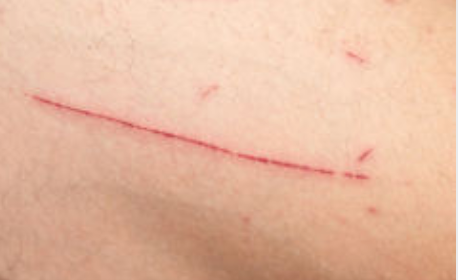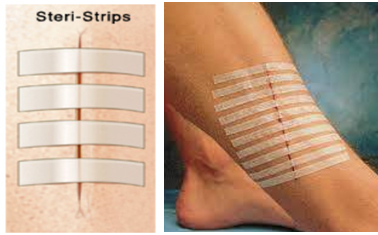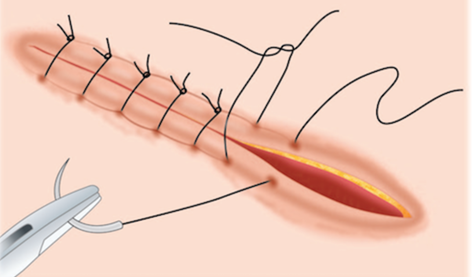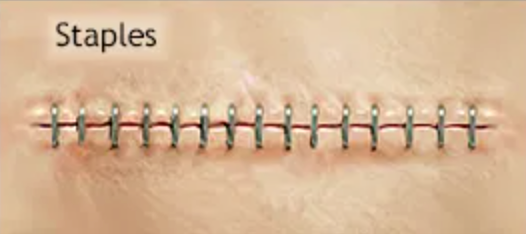How to Care for Your Child with Laceration (cuts)
This leaflet will provide you with information about laceration (cuts), options for treatment and home care advices.
Cuts can happen anywhere. Often, they are not deep and can heal on their own. After examining your child and cleaning the cut, the health care provider could decide whether the cut need closure. There are different ways to manage cuts:
1. Minor and small cuts
These cuts normally will heal on their own in a few days, so they do not need to be closed with stitches or medical glue.

Home care advice
- Keep the wound as dry as possible for 24 hours. You can use a clean, damp cloth to gently wash the skin around it.
- After 24 hours, your child may shower or take a bath.
- If your doctor advises to give medicine for pain, you can give:
- Paracetamol (any brand) or Ibuprofen (any brand)
- Follow the instruction on the medicine package for the correct dose for your child
- Do not give Aspirin to your child as this can cause serious complication
- Some mild redness around the wound is normal. Check the wound every day to make sure the red area is not getting bigger.
- Make sure your child's tetanus vaccine is up to date.
- After the cut has healed, put sunscreen on the scar before your child goes outside. This will help protect the scar from burning and prevent it from getting darker.
When should I seek medical advice?
Seek medical advice if:
- Your child has more redness, warmth or swelling around the wound. These could be signs of an infection.
- There are red streaks coming from the wound.
- Pus is draining from the wound.
- Your child gets a fever.
2. Cuts fixed with skin glue
- Skin glue (special medical glue) holds the edges of a cut together while it heals and helps protect the wound from infection. Slight redness or itchiness around the wound is normal.
- The wound should be healed after 7–10 days, and the glue will fall off on its own.
- Most cuts will leave scar. A scar can form even if a cut is fixed with skin glue. Over time, some scars fade or get smaller.

Home care advice
- Your child should not take baths or swim for a week.
- Your child may shower without covering the cut
- Do not soak or scrub the cut for a week. Dry wet skin by patting it gently.
- If your doctor advises to give medicine for pain, you can give:
- Paracetamol (any brand) or Ibuprofen (any brand)
- Follow the instruction on the medicine package for the correct dose for your child
- Do not give Aspirin to your child as this can cause serious complication
- Do not put antibiotic ointment on the cut. Ointment can dissolve the skin glue.
- Do not use a bandage unless the health care provider tells you to.
- To prevent infection, your child should not pick at the glue or at the scab that forms over the cut.
- After the glue has fallen off and when your child is in the sun, apply sunscreen to the scar as you would for any skin. This will help protect the scar from burning and prevent it from getting darker.
- Make sure your child's tetanus vaccine is up to date.
When should I seek medical advice?
Seek medical advice if:
- The wound starts to bleed and does not stop bleeding after light pressure is applied.
3. Cuts fixed with Adhesive strips
- Some cuts can be closed with adhesive strips also called Steri-strips to bring two sides of skin closure together. These are small pieces of tape used to help fix cuts.
- They can close the edges of a small cut or be placed over stitches to help a wound heal after surgery. You can help prevent infection by taking good care of the cut as it heals.
- Most cuts will leave scar. Over time, some scars fade or get smaller.

Home care advice
- Keep the wound clean and dry for 5 days, then allow water to run over the strips in the shower, but do not scrub them.
- Do not soak the skin.
- Do not let your child pick at adhesive strips. Covering them with gauze can help prevent younger kids from removing them.
- Do not apply ointment because it will loosen the strips.
- Do not cover the strips with a plastic bandage, as this can pull them off.
- Make sure your child's clothing does not rub against the strips.
- Gently trim curling or peeling edges of the strips with nail scissors.
- Make sure your child's tetanus vaccine is up to date.
- Remove all remaining strips after 10 days if your health care provider recommend that you do so.
When should I seek medical advice?
Seek medical advice if:
- Your child has redness, warmth, or swelling around the wound. This could be the start of an infection.
- Red streaks are coming from the wound.
- Pus is draining from the wound.
- The wound is bleeding
- You child develops a fever.
- The edges of the wound start to separate and the wound is opening up.
4. Cut fixed with Stitches
Some cuts need stitches to bring two sides of skin closure together. Most cuts will leave scar. Over time, some scars fade or get smaller.

Home care advice
- Keep wound as dry as possible for 24 hours. You can gently wash the skin around the wound with clean damp cloth.
- After 24 hours, your child may shower or take sponge bath then gently pat the wound dry.
- Do not soak or scrub the cut for a week.
- Your child should not take bath or go to swimming until stitches are removed.
- If your doctor advises to give medicine for pain, you can give:
- Paracetamol (any brand) or Ibuprofen (any brand)
- Follow the instruction on the medicine package for the correct dose for your child
- Do not give Aspirin to your child as this can cause serious complication
- Some mild redness around the wound is normal. Check the wound every day to make sure the red area is not getting bigger.
- The health care provider will advise you when to have the stitches removed if needed. Leaving certain stitches in place too long may cause more scarring.
- Make sure your child's tetanus vaccine is up to date.
- Apply sunscreen on the scar when your child goes out in the sun. This will help protect the scar from burning and prevent it from getting darker.
When should I seek medical advice?
Seek medical advice if:
- Your child has more redness, warmth or swelling around the wound. These could be signs of an infection.
- Red streaks are coming from the wound.
- Pus is draining from the wound.
- The edges of the wound start to separate and stitches started to come out.
- Your child gets a fever.
- The wound is bleeding and does not stop bleeding after you apply light pressure
5. Cuts fixed with Staples
- Some cuts in your child scalp can be closed with staples to bring two sides of skin together. Staples used on the body are different from regular staples used on paper.
- Most cuts will leave scar. Over time, some scars fade or get smaller.

Home care advice
- Keep wound as dry as possible for 24 hours. You can gently wash the skin around the wound with clean damp cloth.
- After 24 hours, your child may shower or take sponge bath then gently pat the wound dry.
- Do not soak or scrub the cut.
- Your child should not take bath or go to swimming until staples are removed.
- If your doctor advises to give medicine for pain, you can give:
- Paracetamol (any brand) or Ibuprofen (any brand)
- Follow the instruction on the medicine package for the correct dose for your child
- Do not give Aspirin to your child as this can cause serious complication
- Some mild redness around the wound is normal. Check the wound every day to make sure the red area is not getting bigger.
- Return to the health care provider as directed to have the staples removed. Leaving the staples in place too long may cause more scarring.
- Make sure your child's tetanus vaccine is up to date.
- Apply sunscreen on the scar when your child goes out in the sun. This will help protect the scar from burning and prevent it from getting darker.
When should I seek medical advice?
Seek medical advice if:
- Your child has more redness, warmth or swelling around the wound. These could be signs of an infection.
- Red streaks are coming from the wound.
- Pus is draining from the wound.
- The edges of the wound start to separate and stitches started to come out.
- Your child gets a fever.
- The wound is bleeding and does not stop bleeding after you apply light pressure

